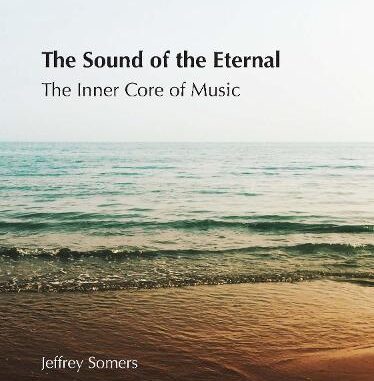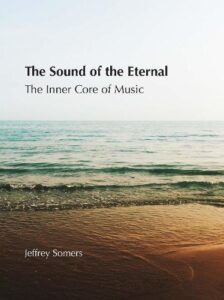

Throughout history people have marvelled at the power of music, and have accounted for its impact through myth, story, science, philosophy, psychology, spirituality and so on.
Jeff Somers, author of The Sound of the Eternal, is a lifelong researcher and collector of music from different traditions, especially Spain, the Middle East and India.
The first chapter states that the aims of the book are:-
1. To ignite an interest in ancient musical traditions through raising awareness of a number of masterworks on music.
2. To provide a detailed discography so that readers can listen for themselves to music from the Near/Middle Eastern, Arabic, Indian and Chinese traditions.
3. To de-mystify musical traditions and encourage people to overcome their fear of “alien” music. Perhaps in overcoming this fear of previously unknown musical traditions, some cultural barriers to mutual understanding may be removed.
4. To make clear the differences between the equal tempered scale which is the basis for modern Western music and the finer intervals found in Eastern and Indian music.
5. To acquaint readers with a body of music which can be seen as a bridge between the ancient traditions of sacred music and the Western tempered scale and which can exert the most profound awakening influence.
6. To encourage readers to undertake their own journey into musical traditions.
The first three aims make immediate sense: the book is an invitation to experience forms of less familiar traditional music, especially that which has a long ancestry and which may be intended to have a transformational inner impact.
The fourth aim seems by contrast technical and specific, yet familiarity with the un-tempered scales really helps readers to appreciate what is conveyed by these more traditional forms of music.
I’ll review the book in light of these aims and give a taste of the content by referring to what catches the attention of this reviewer.
The subsequent chapters explore the fundamentals of an understanding of traditional music, drawing on music from the three broad cultural areas: The Near and Middle East, Spain and India.
Chapter 2 usefully sets the scene by asking how music came into human lives. Was it from natural sounds like birdsong or wind in the reeds, or human speech? Or from the beauty of proportion, or from cosmic harmony or planetary movement? The attractive notion of music as an audible expression of mathematics recurs in different forms through the ages, and through the book.
Chapter 3 asks what music consists of. When does noise become music? How does tension and resolution work, and how does this affect the listener? How does the frequency of vibration of a string or air column provide the basis from which consonance, dissonance and harmony arise? We are also introduced to perhaps the biggest question of all when studying traditional music: why is it that we can either have perfect notes that sound well together, but that cannot support the complex harmony of modern western music (this is the natural scale) or have a scale that supports such harmony and key shift but pays the price that all notes (as on a piano for example) are slightly out of tune (this is the equal tempered scale)? Why does the mathematics of harmony not add up?
Chapter 4 takes us further into the conflict between the traditional natural scale and the Western tempered scale. The essence is that the untempered natural scale has semitones that are not equal so that depending which note you start on, each scale will have its own internal relationships and proportion, giving it a characteristic sound and feeling. It also means that while the notes are in exact harmonic relationship with each other, as soon as you leave that key and go to a neighbouring key, all the notes are slightly out of relation to each other i.e. out of tune. And if you go round all twelve keys you do not arrive back quite where you started. Or in mathematical terms, twelve 5ths does not equal 7 octaves. Pythagoras noted this and named the gap a ’comma’.
For this reason, the equal tempered scale was developed over a century or two, most notably by Bach and his contemporaries, to make all the notes of an equal proportion to each other, so that when you went round the 12 keys you arrived back where you started, thus enabling the complex harmonies that Bach and successive composers needed. However… all the notes of the equal tempered scale except the octave, are just slightly out of tune. A piano is an example of this. We seem to get away with this in western music, but such “out of tuning” would play havoc if applied to traditional music that derives its subtle harmony from the natural proportions of the un-tempered scale. It is this fundamental difference between “Western” music and traditional forms – the use of harmony with multiple instruments and/or voices, compared to a single melodic line with a sustained drone, which the book necessarily and usefully highlights, before going on to examine Arabic, Flamenco, and Indian traditional music.
Chapter 5 introduces the Arabic music system which developed and reached its zenith 1000 years ago, having absorbed significant elements of earlier Persian and Byzantine music systems. It uses the un-tempered scale, and therefore makes little use of overt harmonies, and more use of the resonance between notes in the scale, the notes and the tonic, and the use of octaves.
There has always been a conflict in Islamic countries between the use of music and its prohibition, though the Sufis had no scruples about using music as part of the inner core of spiritual practice. In the Middle Ages this music reached Europe via Spain. And in Chapter 6 the author speaks from his personal experience of studying flamenco in Spain. He talks about Duende, the passionate and fiery spirit of Flamenco, the heightened experience of emotion and urgency around life, death, love and sadness. Somers introduces modes, the foundation harmony of flamenco being the Phrygian mode, which starts with the characteristic semitone, unusual to the western musical ear, and imparting an oriental flavour to the music indicating something of its origin. Flamenco singers also use microtones in the melody, as do the Arabic and Indian traditions, sliding between the notes, rather than stepping from note to note as is usual in western music.
In Chapter 7 Somers considers Indian classical music. Here the traditions are variously concerned with application of universal laws of creation to sound, leading to inner liberation, and the evocation of specific emotions. Indian music also uses an un-tempered scale, dividing the octave into 22 notes. Being un-tempered, the intervals are not equal and the gaps between them differ as they would have done in the west before the equal tempered scale came to predominate.
A Raga is a choice of notes in a scale intended to evoke a specific emotion. It exemplifies a different approach to harmony built on: the dominant note (vadi) played more often than other notes; a second note of almost equal importance (samvadi), a 4th or 5th above the vadi: and underneath this a drone note is played throughout. These three notes provide a basis against which all the notes of the raga take their relationship that are played with and explored for what they evoke.
Chapters 8 and 9 consist of additional material, the first introduces the instruments from the Near and Middle East and India on which the music under discussion is traditionally played, and the second provides a discography with Somers’ further anecdotes and experiences (including a touching Sufi story). Most of these recordings can be found online. Finally there is a relevant bibliography for any reader wishing to pursue their study further.
Does this book achieve the aims Somers sets himself? An appreciative awareness of the trade-off between the equal tempered and the natural scale is essential preparation for the journey into the traditional music Somers speaks of. This is done clearly, and to my mind convincingly, and the theme has necessarily recurred through the book.
The discussion throughout helps us to see how we may have missed out on music that is outside our own culture, and that actually uses different notes that do not exist in our familiar music. This may have caused us to avoid the influence that such music could have had on our lives. The book is successful in meeting these aims, enabling us to see that there is a world to explore, and perhaps a personal journey that beckons each of us.
Somers finishes by reminding us that music touches our innermost being, and it can evoke in us new life, life that gives exaltation to the whole being, raising it toward that perfection in which lies the fulfilment of man’s life. I highly recommend The Sound of the Eternal, not least because Jeff Somers himself has experienced and lived this music personally at source, through communities of musicians, and through his extensive collection of recorded music.
As to whether such music still exists, he says that “My encounters with music traditions from India, the near East and middle East confirm that in spite of adverse external conditions, this music has survived and is waiting to be discovered by more people”.
Adrian Underhill
The Sound of the Eternal: The Inner Core of Music
Author: Jeffrey Somers. Editor: Geoff Butts 2021, Published by Words by Design
ISBN: 978-1-914002-15-1
https://www.waterstones.com/book/the-sound-of-the-eternal/jeffrey-somers/9781914002151